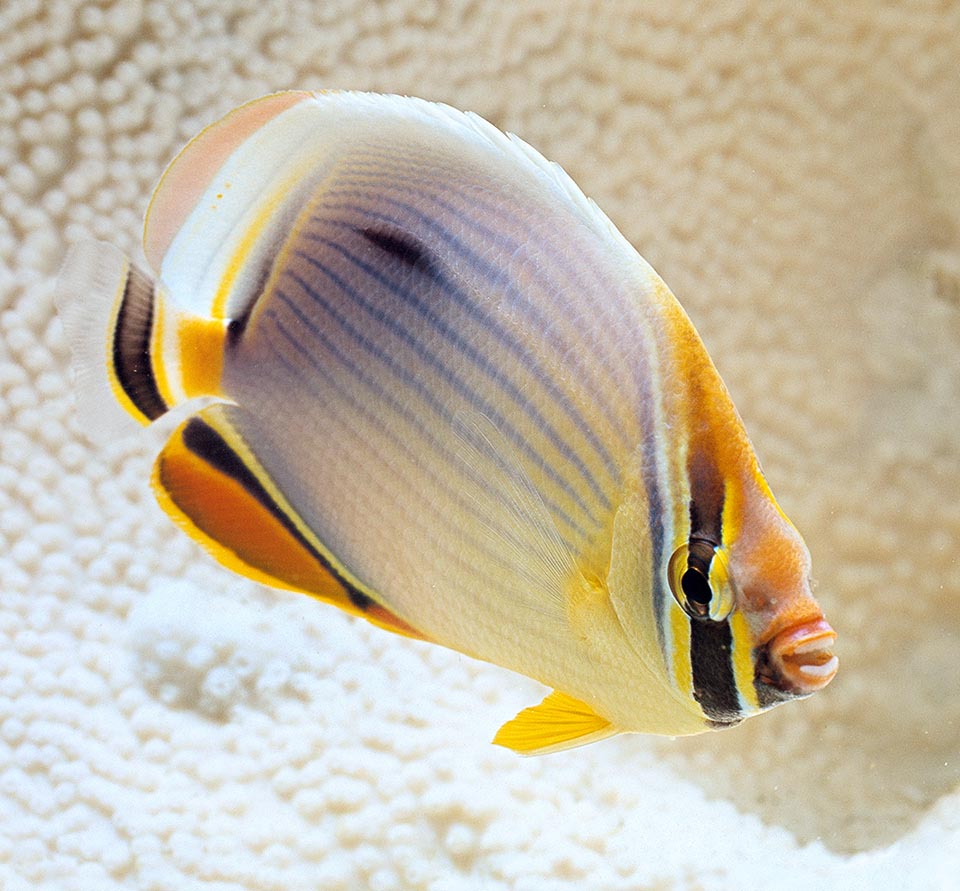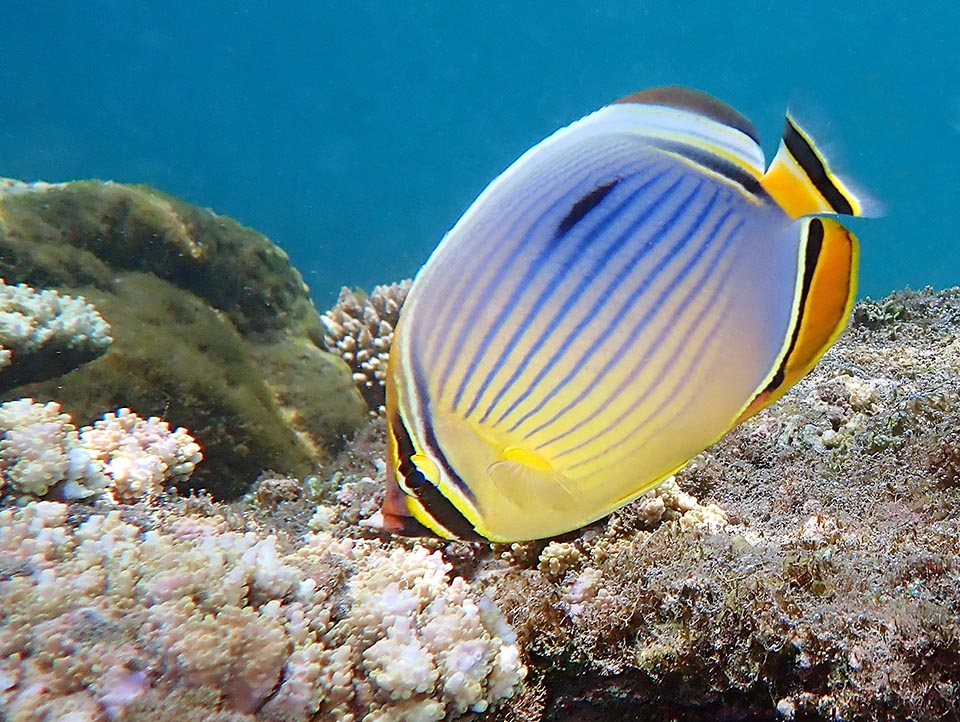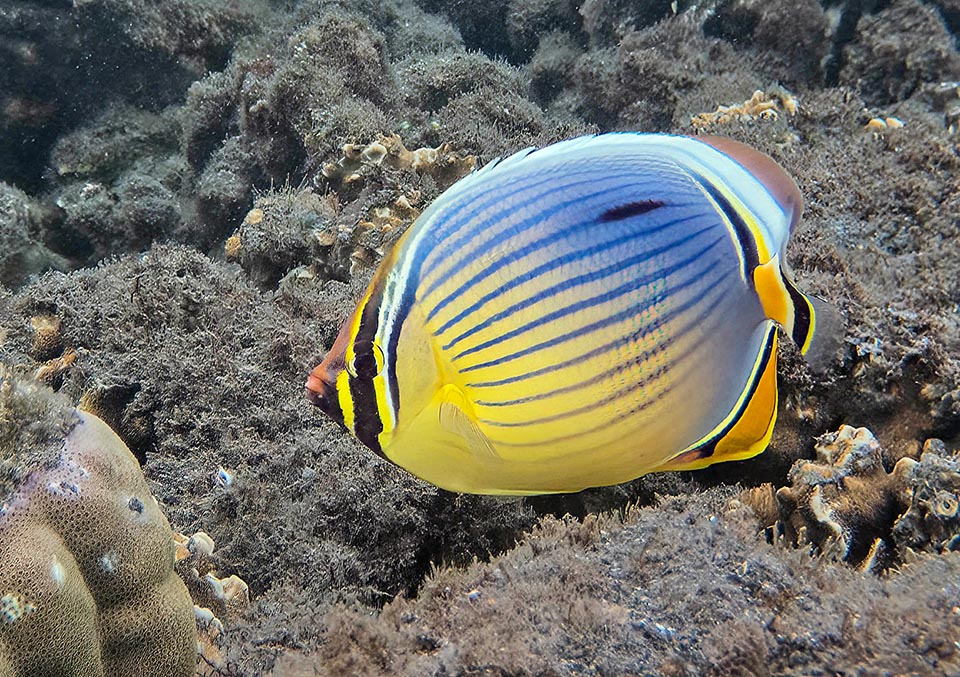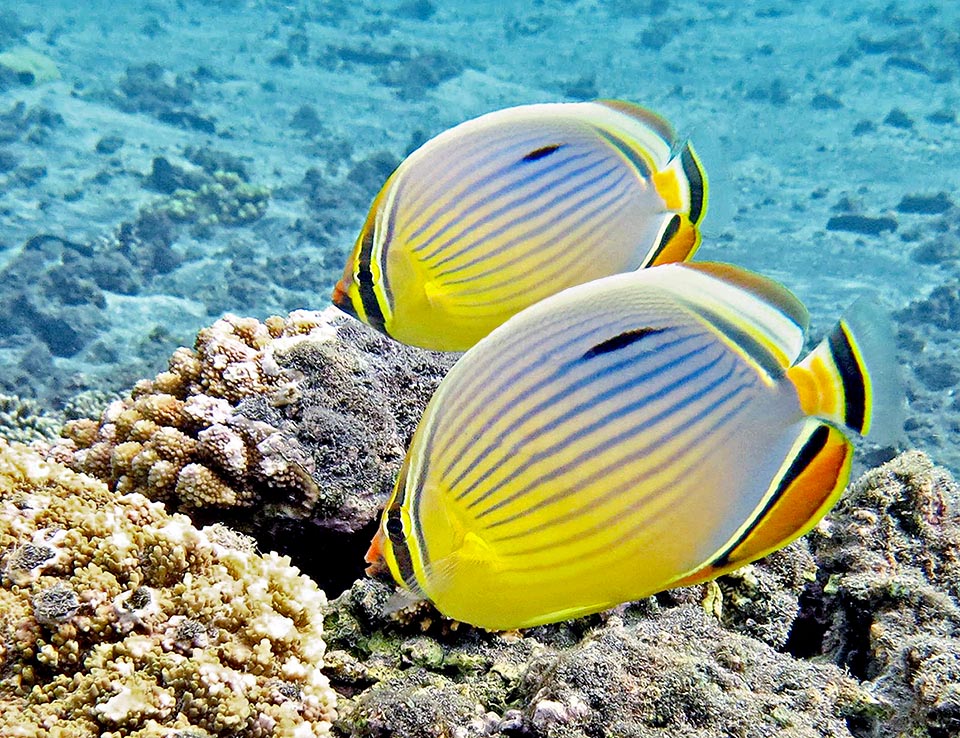Family : Chaetodontidae

Text © Giuseppe Mazza

English translation by Mario Beltramini

Due to its vast presence in the tropical Indo-Pacific, it seems that the Melon butterflyfish is the most common species of the genus Chaetodon © Giuseppe Mazza
The Melon butterflyfish (Chaetodon trifasciatus Park, 1797), belongs to the class of the Actinopterygii, the ray-finned fishes, to the order of Perciformes and to the family of Chaetodontidae.
The name of the genus Chaetodon comes from the Greek “χαίτη” (khaite) = hair and “ὀδούς” (odous) = tooth, due to the “bristle-shaped teeth”.
The name of the species trifasciatus means, in Latin, “with three bands”, with reference to the 3 dark bands on the head.
Zoogeography
It a very vast distribution, the melon butterflyfish is maybe the most common species of the genus Chaetodon. We find it in the Indian Ocean, from South Africa and Madagascar up to Yemen, India, Sri Lanka, Indonesia and Australia, and then in the Pacific, northwards up to southern Japan and eastwards up to the Hawaii and the Tuamotu Archipelago.

It lives in shallow waters, not under the 20 m of depth, eating exclusively coral polyps with a clear preference for those of the madrepores of the genus Pocillopora © Jean-Marie Gradot
Some speak, for the Pacific, of a subspecies, the Chaetodon trifasciatus lunulatus or even of a species, the Chaetodon lunulatus, but the differences are really small and consist mainly in the colour of the caudal peduncle, yellow in the trifasciatus and white in the lunulatus.
Ecology-Habitat
It lives in the shallow water of the madreporic formations, without exceeding the 20 m of depth.
Morpho-physiology
Amongst the butterflyfishes, it is perhaps that who holds the shortest snout. It reaches the 15 cm of length, but usually it does not exceed the 12 cm, with a flat and ovaliform body. The dorsal fin counts 13-14 spiny rays and 20-22 unarmed; the anal has 3 spiny rays and 18-21 soft; the ventral fins 1 spiny ray and 5 soft; the pectoral ones 14-16 unarmed rays and the caudal is more or less rounded.

Consequently, not having to look for food in the ravines, the snout is decidedly short for a butterflyfish © Jean-Marie Gradot
The first of the three dark bands giving the name to the species is little evident, wide but short, it is placed on the tip of the snout under the mouth; the second, the most visible, crosses, as often is the case, the eye, sided by two yellow bands; and the third one, thin and a little paler than the others, starts from the dorsal up to the base of the operculum.
There are then, on the yellow-silvery background colour, about twenty horizontal lines. The fifth shows, in the second half of the body, a thicker dark zone 1 cm long.
The caudal peduncle is orange, like the anal fin which ends with a yellow band, whilst above stands a black band, sided by a yellow one, which reminds dark vertical band with yellow border which delimits the end of the body, from the base of the soft rays of the dorsal to the caudal peduncle. The caudal fin begins with the colour of the peduncle, then detaches on the white, then has a showy black band edged of yellow and finally becomes translucent. Some white is present in the spiny rays of the dorsal fin and in the lower part of the soft rays.
Ethology-Reproductive Biology

Territorial and aggressive towards the other Chaetodon, it lives and reproduces in pairs. Fecundated eggs are entrusted to currents that will take larvae in faraway lands © Jean-Marie Gradot
It is a typically corallivore fish, which nourishes mainly of the madrepores of the genus Pocillopora. When in aquarium, it quickly dies of hunger or poisoned by other species of corals present in the pool which it is not able to digest.
Territorial, lives and reproduces in pair, after a nuptial dance. The eggs are pelagic. The juveniles, white above and yellow under and on the snout, with slight horizontal bands show three black points: the band on the eye, a spot on the peduncle and a band at the base of the anal.
Seen that is of no alimentary value, that it is not pursued by the aquaria lovers and that the populations can double in less than 15 months, the melon butterflyfish is not a species at risk. The fishing vulnerability index, incredibly low, marks just 10 on a scale of 100.
Synonyms
Chaetodon bellus Solander, 1839; Chaetodon layardi Blyth, 1852; Chaetodon ovalis Thiollière, 1857; Chaetodon pepek Montrouzier, 1857; Chaetodon taunigrum Cuvier, 1831; Chaetodon vittatus Bloch & Schneider, 1801; Tetragonoptrus trifasciatus Park, 1797.
→ For general information about FISH please click here.
→ For general information about BONY FISH please click here
→ For general information about CARTILAGINOUS FISH please click here.
→ To appreciate the BIODIVERSITY of BONY FISH please click here.
→ To appreciate the BIODIVERSITY of CARTILAGINOUS FISH please click here.
